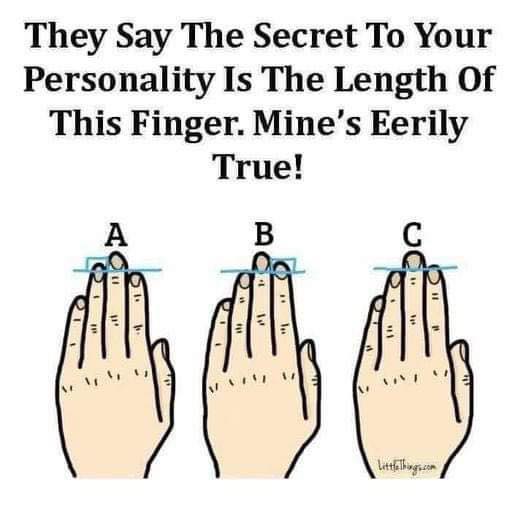The idea that the length of our fingers, particularly the ratio between the index finger (2D) and the ring finger (4D), can reveal something intrinsic about our personality is a fascinating one—though it’s important to recognize that this is rooted in pseudoscience rather than proven science. Still, it’s intriguing to think that such a simple, physical trait might somehow tell us about a person’s tendencies, behavior, or even character. It’s a concept that has captivated many, inspiring countless individuals to look at their hands in a new way and wonder if there’s truth behind the claims.
You see, the “digit ratio,” especially that between the index and ring finger, has gained popularity because of what some call the “2D:4D ratio.” Essentially, if your ring finger is longer than your index finger, you’re thought to be a risk-taker—assertive, ambitious, outgoing, and perhaps even a bit aggressive. People with a lower 2D:4D ratio are often described as confident and competitive, maintaining high self-esteem and a drive to succeed. Conversely, if your index finger is longer, it’s said you tend toward compassion, empathy, and nurturing qualities. Such individuals are believed to be more conscious of others’ feelings and more inclined to avoid conflict, preferring a more cooperative approach to life.

And then, there are the people with fingers that are pretty much of equal length. In those cases, it’s suggested they might exhibit a complex balance—sometimes assertive, sometimes compassionate—adapting to circumstances with ease. This, of course, paints a very simplified picture of human personality, but it’s a picture that has attracted many believers worldwide, especially among those interested in alternative, mystical, or intuitive ways of understanding oneself.
The origins of this concept go back quite a ways, although it gained significant momentum through the work of evolutionary biologist John Manning, who is now at Swansea University. Over the past two decades, Manning has inspired more than 1,400 studies exploring the links between finger ratios and a broad range of traits—cognitive abilities, risk-taking propensity, susceptibility to certain diseases, even aspects related to gender identity. Some researchers have even pointed to ancient cave painters, suggesting that their finger ratios might tell us whether they were more male or female, more assertive or nurturing, based on the pseudoscientific criteria of the time.
The scientific community, however, remains skeptical. Many deny that finger ratio can reliably predict personality, considering these ideas as intriguing but ultimately unsubstantiated. It’s broadly accepted that personality is a complex and layered construct, influenced mainly by genetics, environment, upbringing, and individual experiences. The notion that something as simple as finger length could serve as an accurate, non-invasive window into our psyche seems overly simplistic at best—and outright misleading at worst.
That said, the explanation behind why some researchers have correlated prenatal hormone exposure—like testosterone—with finger length is interesting. In the late 1950s, scientists began exploring how hormones involved in fetal development might influence later behavior and traits. Because direct sampling of fetal hormones was risky and impractical, finger ratios emerged as a kind of biological shortcut—an unobtrusive indicator believed to reflect the levels of testosterone or estrogen a fetus was exposed to in the womb. Based on this, certain personality traits, tendencies toward aggression, or even preferences related to gender identity became topics of speculation.
I think what’s fascinating about this is how the idea captures our innate curiosity about bodies and personalities. It offers a simple, almost poetic shorthand—look at someone’s hands, and you might glimpse some unseen aspect of who they are. Of course, the human mind loves patterns and stories, and it’s tempting to see meaning in tiny details like finger ratios. We want to understand ourselves better, to peek behind the surface and discover that there’s a hidden code—one that might unlock secrets about our behavior, predispositions, and even our destiny.
But at the same time, it’s important to approach such claims with caution. While the research from John Manning and others is intriguing, it doesn’t prove causation or even really establish a reliable rule. People are more complex than that. Our personalities aren’t just shaped in the womb—they’re shaped through a lifetime of experiences, choices, and circumstances. A person with a longer ring finger might be adventurous, but that doesn’t mean everyone with that finger will be. Or that someone with a longer index finger can’t be a brave, confident leader.
Still, I can’t help but feel a sense of wonder whenever I think about these ideas. Our bodies are mysterious, intricate, and often full of surprises. Whether or not the pose of a person’s fingers reveals their true personality, it’s a reminder that we are all woven from countless layers—biology, environment, dreams, fears. Maybe there’s some truth in the idea that our physical traits hold clues to who we are—perhaps not as labels or definitive markers but as symbols, part of a larger story that we’re still learning how to interpret.



